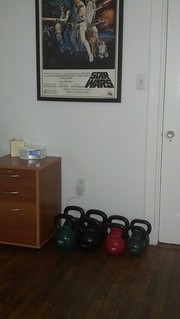There was a time when I hated kettlebells. Okay maybe hate’s a strong word. Hate is something that’s reserved for things like Hitler, terrorists, sub-prime mortgage loans, and poodles.
Disliked may be a more appropriate term in this context.
Regardless there was a time when I felt kettlebells were nothing more than a fad – look Ma, a cannonball with handles!! – that the fitness industry latched on to because it was something new (to us Westerners, anyways), and that it would run its course before you could say “stone washed jeans” or “Gangnam Style.” For real.
LOL – shows how much I know. I also remember back in the late 90s when this white rapper from Detroit with a funny name burst onto the scene. I thought he was some joke or gimmick, a one-hit wonder at best. There was no way he was going to last!
Eminem seems to have done alright for himself.
Fast forward to today and my feelings towards kettlebells have changed. Now, I’m not someone who’s a “kettlebell guy” per se. I don’t solely use kettlebells or claim that they’re somehow superior to anything else.
I always find it comical whenever a coach or trainer claims kettlebells trump anything else out there, as if barbells and dumbbells are now obsolete.
Last time I checked weight is weight, and the body can’t differentiate between a DB Goblet Squat or a KB Goblet Squat, or a DB row compared to a KB row.
Of course there are variables and advantages that a KB offers that other pieces of equipment can’t touch with a ten-foot pole, which is why I feel they’re a valuable TOOL in the toolbox. They, along with everything else in our arsenal – barbells, dumbbells, TRX, bands, chains, Prowlers, selectorized machines, lightsabers, and yes, even BOSU balls – have their place.
However, it all comes at a price.
You see, kettlebells are a blessing and a curse.
A blessing in that they’re one of the most versatile pieces of equipment you can ask for.
They’re a wonderful teaching tool to groove a proper squat and hip hinge pattern, not to mention you can push, pull, carry, and swing the son-of-a-bitch to your hearts content.
All while taking up minimal gym space, as is the case with my stash of KBs in my office:

Conversely, KBs are a curse in that they’re one of the more innocuous looking pieces of equipment out there – seriously Ma, look. A cannonball! With a handle! Weeeeeeeee – and many, many, MANY people (trainers and coaches included) have no clue how to properly use them, let alone coach others to use them correctly.
To help save face, below are some blogs and articles you may find helpful.
HERE is a post (including a killer video by Artemis Scantalides and Eric Gahan of Iron Body Studios) on how to coach a proper swing pattern.
HERE is a post on a few (overlooked) tips on how to clean up KB swing technique.
And HERE’s a post on “stuff” you can do with a kettlebell to kick your own ass.
All of those would be fantastic starting points, but I’d also encourage those looking to take their KB skills to Jedi level to seek out further assistance from the likes of StrongFirst or DragonDoor.
Today, though, I wanted to tackle a few common mistakes people make with how they handle the kettlebell (<— no pun intended).
More specifically with how they pick it up and put it down. I know it sounds silly, but it’s a mistake that a lot of people make (trainers and coaches included) which could lead to injury of you’re not careful.
Point blank: there IS a right and wrong way to pick up a kettlebell to start a swing, or get-up, or any exercise for that matter, and one simple litmus test you can use to gauge one’s KB knowledge is to see whether or not he or she follows this protocol:


